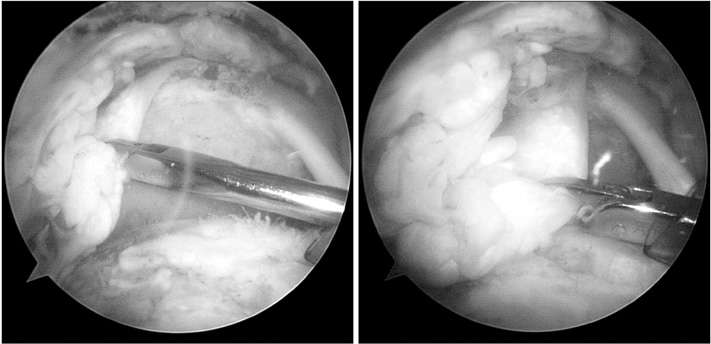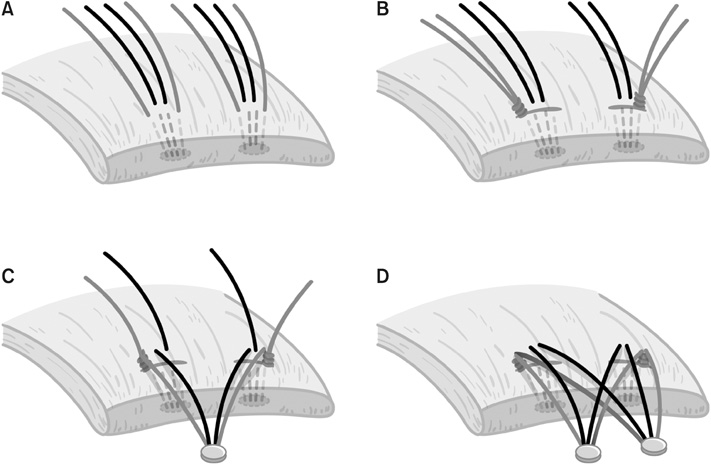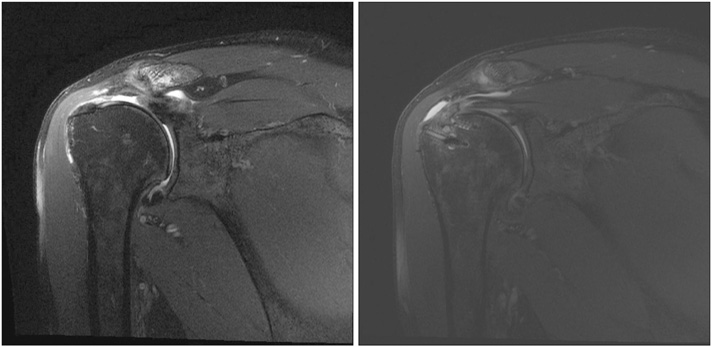J Korean Orthop Assoc.
2017 Oct;52(5):392-402. 10.4055/jkoa.2017.52.5.392.
A Modified Mac Suture Bridge Technique: Clinical and Radiological Outcomes of the Treatment of Rotator Cuff Tear with Poor Tissue Quality
- Affiliations
-
- 1Department of Orthopedic Surgery, Pusan National University School of Medicine, Busan, Korea. scheon@pusan.ac.kr
- KMID: 2393511
- DOI: http://doi.org/10.4055/jkoa.2017.52.5.392
Abstract
- PURPOSE
Base on the concept of the Mac stitch, we designed the modified Mac-suture bridge technique to improve the outcome of arthroscopic repair of rotator cuff tear with poor tissue quality. Moreover, we evaluated both the radiological and clinical outcomes of the surgery to assess the effectiveness of the newly designed technique.
MATERIALS AND METHODS
From January 2010 to December 2014, a total of 52 patients (25 males, 27 females) with rotator cuff tear, with poor tissue quality according to both radiological and intraoperative findings, who underwent arthroscopic rotator cuff repair using the modified Mac-suture bridge technique and followed-up for at least 1 year were included in this study. The mean patient age at the time of surgery was 60 years. The average follow-up period was 20 months. We evaluated the clinical outcomes by checking the range of motion and compared the following, both preoperatively and postoperatively: American Shoulder and Elbow Surgeon (ASES) score, University of California, Los Angeles (UCLA) score, Constant shoulder score (CSS), visual analogue scale (VAS). In addition, we analyzed 42 series of postoperative magnetic resonance imaging by using the Sugaya's classification for the evaluation of the repair integrity.
RESULTS
All clinical scores showed significant improvement (ASES score improved from 56.75 to 83.44, UCLA score from 20.52 to 29.23, CSS from 64.04 to 80.90, and VAS from 6.17 to 1.62; p<0.001). The range of motion was also improved; forward flexion improved from 108° to 158°, abduction from 109° to 160°, external rotation from 27° to 50°, and internal rotation from 31° to 57° (p<0.001). Satisfactory radiologic results were noted on postoperative magnetic resonance imaging, consisting of 15 cases (35.7%) type I, 22 cases (52.4%) type II, 3 cases (7.1%) type III, 2 cases (4.8%) type IV, and no type V, according to the Sugaya's method.
CONCLUSION
The modified Mac-suture bridge technique provided satisfactory results both radiologically and clinically for the treatment of rotator cuff tear with poor tendon tissue quality. It could possibly be a good alternative to previous techniques of arthroscopic repair.
Keyword
MeSH Terms
Figure
Reference
-
1. Wilson F, Hinov V, Adams G. Arthroscopic repair of full-thickness tears of the rotator cuff: 2- to 14-year follow-up. Arthroscopy. 2002; 18:136–144.2. Gerber C, Fuchs B, Hodler J. The results of repair of massive tears of the rotator cuff. J Bone Joint Surg Am. 2000; 82:505–515.
Article3. Oh JH, Kim SH, Ji HM, Jo KH, Bin SW, Gong HS. Prognostic factors affecting anatomic outcome of rotator cuff repair and correlation with functional outcome. Arthroscopy. 2009; 25:30–39.
Article4. Djurasovic M, Marra G, Arroyo JS, Pollock RG, Flatow EL, Bigliani LU. Revision rotator cuff repair: factors influencing results. J Bone Joint Surg Am. 2001; 83-A:1849–1855.
Article5. Lädermann A, Denard PJ, Burkhart SS. Management of failed rotator cuff repair: a systematic review. J ISAKOS. 2016; 1:32–37.
Article6. Denard PJ, Burkhart SS. Techniques for managing poor quality tissue and bone during arthroscopic rotator cuff repair. Arthroscopy. 2011; 27:1409–1421.
Article7. Meier SW, Meier JD. Rotator cuff repair: the effect of double-row fixation on three-dimensional repair site. J Shoulder Elbow Surg. 2006; 15:691–696.
Article8. Shin SJ. Arthroscopic rotator cuff repair: double rows & suture bridge technique. J Korean Shoulder Elbow Soc. 2008; 11:82–89.9. MacGillivray JD, Ma CB. An arthroscopic stitch for massive rotator cuff tears: the Mac stitch. Arthroscopy. 2004; 20:669–671.
Article10. Sein ML, Walton J, Linklater J, et al. Reliability of MRI assessment of supraspinatus tendinopathy. Br J Sports Med. 2007; 41:e9.
Article11. Goutallier D, Postel JM, Gleyze P, Leguilloux P, Van Driessche S. Influence of cuff muscle fatty degeneration on anatomic and functional outcomes after simple suture of full-thickness tears. J Shoulder Elbow Surg. 2003; 12:550–554.
Article12. Sugaya H, Maeda K, Matsuki K, Moriishi J. Repair integrity and functional outcome after arthroscopic double-row rotator cuff repair. A prospective outcome study. J Bone Joint Surg Am. 2007; 89:953–960.13. Chung SW, Kim JY, Kim MH, Kim SH, Oh JH. Arthroscopic repair of massive rotator cuff tears: outcome and analysis of factors associated with healing failure or poor postoperative function. Am J Sports Med. 2013; 41:1674–1683.14. Morag Y, Jacobson JA, Miller B, De Maeseneer M, Girish G, Jamadar D. MR imaging of rotator cuff injury: what the clinician needs to know. Radiographics. 2006; 26:1045–1065.
Article15. Ahmad S, Haber M, Bokor DJ. The influence of intraoperative factors and postoperative rehabilitation compliance on the integrity of the rotator cuff after arthroscopic repair. J Shoulder Elbow Surg. 2015; 24:229–235.
Article16. Choi ES, Park KJ, Kim YM, et al. Clinical result of layered suture bridge technique in arthroscopic repair for delaminated rotator cuff tear. Clin Should Elbow. 2013; 16:84–93.
Article17. Schneeberger AG, von Roll A, Kalberer F, Jacob HA, Gerber C. Mechanical strength of arthroscopic rotator cuff repair techniques: an in vitro study. J Bone Joint Surg Am. 2002; 84-A:2152–2160.18. Rhee YG, Cho NS, Parke CS. Arthroscopic rotator cuff repair using modified Mason-Allen medial row stitch: knotless versus knot-tying suture bridge technique. Am J Sports Med. 2012; 40:2440–2447.19. Lee BG, Cho NS, Rhee YG. Modified Mason-Allen suture bridge technique: a new suture bridge technique with improved tissue holding by the modified Mason-Allen stitch. Clin Orthop Surg. 2012; 4:242–245.
Article20. Ma CB, Comerford L, Wilson J, Puttlitz CM. Biomechanical evaluation of arthroscopic rotator cuff repairs: double-row compared with single-row fixation. J Bone Joint Surg Am. 2006; 88:403–410.21. Ko SH, Cho SD, Jung KH, et al. All arthroscopic repairs with massive cuff stitch in medium-sized full thickness rotator cuff tears. J Korean Orthop Assoc. 2008; 43:93–100.
Article22. Sugaya H, Maeda K, Matsuki K, Moriishi J. Functional and structural outcome after arthroscopic full-thickness rotator cuff repair: single-row versus dual-row fixation. Arthroscopy. 2005; 21:1307–1316.
Article23. Lichtenberg S, Liem D, Magosch P, Habermeyer P. Influence of tendon healing after arthroscopic rotator cuff repair on clinical outcome using single-row Mason-Allen suture technique: a prospective, MRI controlled study. Knee Surg Sports Traumatol Arthrosc. 2006; 14:1200–1206.
Article24. Kim KC, Shin HD, Lee WY, Han SC. Repair integrity and functional outcome after arthroscopic rotator cuff repair: double-row versus suture-bridge technique. Am J Sports Med. 2012; 40:294–299.25. Baleani M, Ohman C, Guandalini L, et al. Comparative study of different tendon grasping techniques for arthroscopic repair of the rotator cuff. Clin Biomech (Bristol, Avon). 2006; 21:799–803.
Article
- Full Text Links
- Actions
-
Cited
- CITED
-
- Close
- Share
- Similar articles
-
- Arthroscopic Rotator Cuff Repair: Double Rows & Suture Bridge Technique
- Modified Mason-Allen Suture Bridge Technique: A New Suture Bridge Technique with Improved Tissue Holding by the Modified Mason-Allen Stitch
- Biomechanical Test for Repair Technique of Full-thickness Rotator Cuff Tear
- New Retear Pattern after Rotator Cuff Repair at Previous Intact Portion of Rotator Cuff
- Clinical and Radiological Evaluation after Arthroscopic Rotator Cuff Repair Using Suture Bridge Technique





